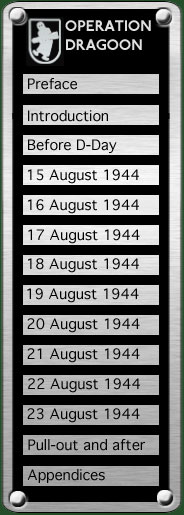
|
||
Jagdfliegerführer Süd Not initially subordinated to Fl.Div. 2, Jafü Süd, controlled the fighter defence of Southern France, such as it was. The post was held by Oberst Friedrich Vollbracht (a former Kommodore of ZG 2 and holder of the Ritterkreuz), his callsign was "ÖDIPUS". An Allied Intelligence assessment after the campaign concluded: During the summer of 1944 the German Fighter Commander, S. FRANCE had everything necessary to meet air attacks within his territory — everything but a fighter force. He was served by an adequate organisation for reporting, plotting and controlling aircraft. His network of communications with this organisation and with other headquarters was also adequate. But, with hardly more than a single Gruppe of fighters, the system proved almost wholly futile. His HQ, Chateau La Nerthe (near Chateauneuf-du-Pape, about 10 km south south east of Orange) had been requisitioned on 21 June 1943 although Vollbracht and his staff did not move in until 1 May 1944, along with Stab/Ln.-Rgt. 51. Major Krauthausen, the regimental commander doubled as Vollbracht’s Signals Leader. On 25 July 1944, the Jafü’s staff consisted of seven officers, two “officials”, 25 NCOs and 14 other ranks. The Ln.-Rgt. contingent at the chateau had 5 officers, 3 officials, 15 NCOs and 7 other ranks. Landline communications included links to 2./NAG 13 at Cuers; 1. and 3. JGr. 200 at Aix-les-Milles and 2./JGr. 200 at Avignon-East; Stab/2. Fl.Div. at Montfrin; and Jägerleitstelle West at Pinerolo (south west of Torino, Italy). According to documents found at La Nerthe, by 16 August all the Staffeln of JGr. 200 were based at Avignon and the Aix message centre was dismantled. Jagdgruppe 200 Follow the link for as complete a history of JGr. 200 as I can manage. Seenotkommando Berre (Seenotstaffel 3) This air/sea rescue unit was clearly conscious of its exposed position, asking its higher authority on 22 July where it should go in the event of an Allied landing on the Mediterranean coast and suggesting a move to Friedrichshafen by way of Lyon. This was evidently taken up because the Kommando oversaw the transfer of two Do 24 T-3 (W.Nr. 1002 and 3348) to Friedrichshafen at 06.25 on 3 August. A third (W.Nr. 1032) was destroyed that day by Spitfires of No. 72 Squadron RAF while taxying on the Étang de Berre. Feldwebel Walter Meyer died of his wounds while his five crewmates were slightly injured; the men were rescued by two of the unit’s crash boats. In addition, Do 24 W.Nr. 53 incurred damage to its port wing during the day.
On 5 August, Seenotstaffel 3 reported the following aircraft on strength:
continued on next page...
|
|||||||||||||||||||||||||||||||

